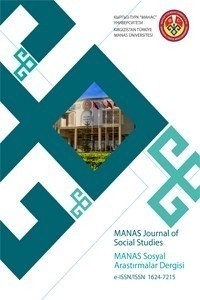Öz
This study investigates the most appropriate method for modelling the volatility for nominal exchange rate by using the ARCH type models. The research covers the period of 2002-2017 of nominal exchange rate using daily data. It is observed that the volatility of nominal exchange rate has the ARCH effect and the most appropriate model for forecasting the volatility of nominal exchange rate is GARCH(1,2) because it has the lowest Akaike Information Criterion. Furthermore, during the crises and uncertain periods, the volatility of nominal exchange rate series increases and volatility clustering is observed, meaning high volatility tends to follow high volatility and it is true for vice versa.
Anahtar Kelimeler
ARCH GARCH Akaike information criterion Volatility Clustering
Kaynakça
- Akgiray, V., (1989). Conditional heteroscedasticity in time series of stock returns: evidence and forecasts. The Journal of Business, 62, pp. 55-80.
- Alberg, D., Shalit, H., and Yosef, R., (2008). Estimating stock market volatilityusing asymmetric GARCH models. Applied Financial Economics, 18 (15), pp. 1201-1208.
- Baillie, R.T. and De Gennaro, R.P., (1990). Stock returns and volatility. Journal of Financial and Quantitative Analysis, 25. No.2.
- Bollerslev, T., (1986). Generalized autoregressive conditional heteroscedasticity. Journal of Econometrics, 31, pp. 307-327.
- Cao, C.Q. and Tsay, R.S., (1992). Nonlinear time –series analysis of stock volatilities. Journal of Applied Econometrics, 7, pp. 165-185.
- Dralle, B., (2011). Modelling volatility in financial time series. Master’s Thesis, Mathematics, Statistics and Computer Science, University of KwaZulu-Natal, Pietermaritzburg.
- Engle, R.F., (1982). Autoregressive conditional heteroscedasticity with estimates of the variance of United Kingdom Inflation. Econometrica, 50. 987-1007.
- Engle, R.F., (1982). Statistical models for financial volatility. Financial Analysts Journal, 49, pp. 72-78.
- Fama, E.F., (1965). The behavior of stock market prices. Journal of Business, 38(1), pp. 34-105.
- Huang, D., Wang, H., and Yao, Q., 2008. Estimating GARCH models : when to use what? The Econometrics Journal, 11, pp. 27-38.
- Karmakar, M., (2006). Stock market volatility in the long run, 1961-2005. Economic and Political Weekly, 41, No. 18, pp. 1796-1802.
- Mandelbrot, B., (1963). The variation of certain speculative prices. Journal of Business. 26, pp. 394-419.
- Oskooee, M.B. and Hegerty, S.W., 2007. Exchange rate volatility and trade flows: a review article. Journal of Economic Studies, 34.
- Talke, I.S., (2003). Modelling volatility in financial time series data, Master’s Thesis, Mathematics, Statistics, and Information Technology, University of Kwazulu-Natal, Pietermaritzburg.
Öz
Bu çalışma, ARCH tipi modelleri kullanarak nominal döviz kurundaki oynaklığı modelleyen en uygun metodu bulmaya çalışmaktadır. Araştırma verisi 2002-2017 yılları için günlük verileri kapsamaktadır. Döviz kurundaki dalgalanmanın ARCH etkisine sahip olduğu ve nominal döviz kurunu tahminde en uygun modelin en düşük Akaike bilgi kriterine sahip olmasından dolayı GARCH(1,2) olduğu bulunmuştur. Ayrıca, kriz ve belirsizlik dönemlerinde nominal döviz kuru serisinde artışlar olduğu ve yüksek dalgalanmayı yüksek dalgalanmanın takip ettiği kümelenmenin görüldüğü gözlemlenmiştir.
Anahtar Kelimeler
Kaynakça
- Akgiray, V., (1989). Conditional heteroscedasticity in time series of stock returns: evidence and forecasts. The Journal of Business, 62, pp. 55-80.
- Alberg, D., Shalit, H., and Yosef, R., (2008). Estimating stock market volatilityusing asymmetric GARCH models. Applied Financial Economics, 18 (15), pp. 1201-1208.
- Baillie, R.T. and De Gennaro, R.P., (1990). Stock returns and volatility. Journal of Financial and Quantitative Analysis, 25. No.2.
- Bollerslev, T., (1986). Generalized autoregressive conditional heteroscedasticity. Journal of Econometrics, 31, pp. 307-327.
- Cao, C.Q. and Tsay, R.S., (1992). Nonlinear time –series analysis of stock volatilities. Journal of Applied Econometrics, 7, pp. 165-185.
- Dralle, B., (2011). Modelling volatility in financial time series. Master’s Thesis, Mathematics, Statistics and Computer Science, University of KwaZulu-Natal, Pietermaritzburg.
- Engle, R.F., (1982). Autoregressive conditional heteroscedasticity with estimates of the variance of United Kingdom Inflation. Econometrica, 50. 987-1007.
- Engle, R.F., (1982). Statistical models for financial volatility. Financial Analysts Journal, 49, pp. 72-78.
- Fama, E.F., (1965). The behavior of stock market prices. Journal of Business, 38(1), pp. 34-105.
- Huang, D., Wang, H., and Yao, Q., 2008. Estimating GARCH models : when to use what? The Econometrics Journal, 11, pp. 27-38.
- Karmakar, M., (2006). Stock market volatility in the long run, 1961-2005. Economic and Political Weekly, 41, No. 18, pp. 1796-1802.
- Mandelbrot, B., (1963). The variation of certain speculative prices. Journal of Business. 26, pp. 394-419.
- Oskooee, M.B. and Hegerty, S.W., 2007. Exchange rate volatility and trade flows: a review article. Journal of Economic Studies, 34.
- Talke, I.S., (2003). Modelling volatility in financial time series data, Master’s Thesis, Mathematics, Statistics, and Information Technology, University of Kwazulu-Natal, Pietermaritzburg.
Ayrıntılar
| Birincil Dil | İngilizce |
|---|---|
| Bölüm | Araştırma Makalesi |
| Yazarlar | |
| Yayımlanma Tarihi | 24 Nisan 2020 |
| Gönderilme Tarihi | 18 Mart 2019 |
| Yayımlandığı Sayı | Yıl 2020 Cilt: 9 Sayı: 2 |
Kaynak Göster
Cited By
Türkiye’de Sepet Kur Volatilitesinin GARCH Modellemesi: Asimetri Etkisi Yaklaşımı
Akademik Araştırmalar ve Çalışmalar Dergisi (AKAD)
https://doi.org/10.20990/kilisiibfakademik.796117
Exploring the determinants of renewable energy consumption in Nigeria: an ARDL analysis from 1990–2022
African Journal of Economic and Management Studies
https://doi.org/10.1108/AJEMS-06-2024-0351
MANAS Journal of Social Studies (MANAS Sosyal Araştırmalar Dergisi)

